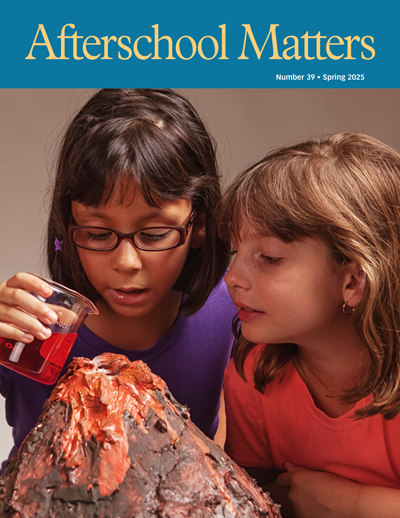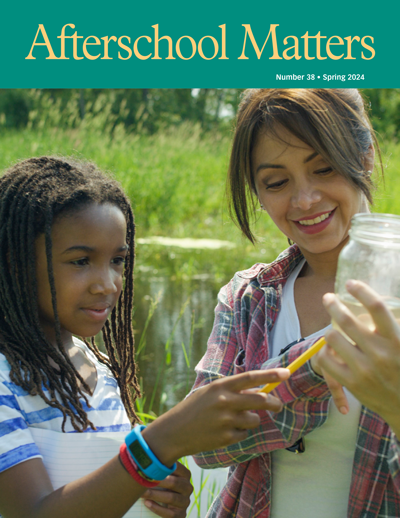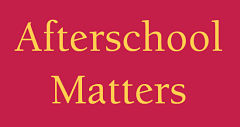Welcome from the Managing Editor of Afterschool Matters, Spring 2019
By Georgia Hall
About eight years ago, I took my then six-year-old daughter to a local children’s theater performance of The Wizard of Oz. During intermission, she made it clear to me that, next time, she wanted to be on stage. So began an incredible journey into the dramatic arts that was topped off last January with her final youth theater performance.
Continue Reading
How Creative Youth Development Can Lead to Peace
By Adam Jacobs
“The person who fell off the person who fell off.” This was the response of four-year-old Aaron to the question, “What do you want to do a play about?” in the Kids Creative Summer Camp. Aaron meant to say “the person who fell off” only once. In most settings, such an accidental double phrasing would be corrected and forgotten. However, in Kids Creative, the rule is “All ideas are good.” Other campers built on Aaron’s slip-up to create a play called “The Journey to Find The Person Who Fell Off The Person Who Fell Off.” This group of 20 children, ages 4 to 12, who came from various New York City schools, engaged in a brainstorming session in which they shared ideas and asked questions. Everyone in the group, including the teaching artists, added their own ideas using the phrase, “Yes, and….” A storyline took shape: The vice president of Chocolateville was standing on the shoulders of the president of Chocolateville at their inauguration when they both slipped into the Chocolate River. Now a group of heroes has to make a treacherous journey to find them. Each child created his or her character, and the group found ways to weave the story together. Thanks to the Kids Creative processoriented environment, one idea from a four-year-old child developed into a five-part musical play, which was performed for friends and family at the close of the camp session.
Continue Reading
Dynamic Online STEM Professional Development
By Alexandria Brasili and Sue Allen
A group of six afterschool educators come together for a monthly professional development course in which they are learning to facilitate STEM programs effectively. Today’s meeting focuses on how to model science practices. To begin the meeting, the facilitator sets up an icebreaker to allow the other five educators to get to know one another better. The facilitator asks, “What upcoming STEM program are you most excited about?” Sofia, an afterschool educator at a 4-H program, talks about the summer coding club that she is starting; the other participants join in.
Continue Reading
A Research Synthesis
By Nancy Erbstein and James O. Fabionar
Scholars in many fields have documented that the sharp population increase among Latinx people in the U.S. has been accompanied by myriad social challenges (Suárez-Orozco & Suárez-Orozco, 2009). Both established populations and new arrivals struggle to obtain quality education, adequate healthcare, and employment that pays a living wage; they also deal with various forms of discrimination. Analyses repeatedly indicate that these and other issues often shape the daily lives and developmental trajectories of Latinx youth. These social issues also undermine Latinx participation in out-of-school time (OST) programs, which hold potential to promote youth well-being (Guzman-Rocha, McLeod, & Bohnert, 2017). Increasingly, leaders of youth-serving organizations voice concern about low Latinx participation (Borden et al., 2006), often recognizing that poor participation reflects a need to develop new capacities and inclusive practices (Perkins et al., 2007).
Continue Reading
A Practical Guide for Evaluators and Practitioners
By Lizzie Murchison, Katie Brohawn, Cheri Fancsali, Andrea D. Beesley, and Erin Stafford
Funders and policymakers are increasingly recognizing the afterschool field for its vital role in supporting the social and emotional growth and academic achievement of school-age youth. Although this recognition is welcome, it often comes with increased expectations for high-quality research demonstrating the value of programming. To satisfy these demands and make the most of funding opportunities, practitioners must develop strong partnerships with external evaluators. However, developing afterschool evaluation partnerships that work well for all parties is often far more difficult than program directors or evaluators anticipate.
Continue Reading
Design-Based STEM Programming for Girls
By Jasmine M. Nation, Danielle Harlow, Diana J. Arya, and Maya Longtin
“I am a scientist. I’m not like a scientist.” We were excited to hear this response from one of the girls who participated in our afterschool program focused on science, technology, engineering, and mathematics (STEM). The STEMinist Program was a research-practice collaboration between university researchers and an afterschool program for female students in grades 4 to 6. This article describes how the program’s ongoing design transformations increased girls’ understanding of and interest in STEM. Design-based framing (Barab & Squire, 2009) enabled ongoing adjustments to the program while also identifying best practices for afterschool STEM learning. To understand the program’s progression and outcomes, we examined the features of the learning environment and the relationships among design components by analyzing qualitative data collected before, during, and after program implementation. Participants’ perceptions of science and scientists helped us understand the impact of the program and ways to improve it.
Continue Reading
The Key to Student Success in Afterschool Programs
By Ginger Shea
Student success and achievement in afterschool programs depend on caring adults who go above and beyond to make children feel that they are special and can achieve anything (Akhavan, Emery, Shea, & Taha-Resnick, 2017). In the Oxnard (California) School District, where I am the afterschool grant manager, many of the 200 staff in the Oxnard Scholars afterschool program are working in their first job. This is the first time they have been in charge of young people and the first time they have been called “teacher.” These firsts can be drawbacks, but they also can create powerful opportunities to build staff members’ capacity to engage students and enrich their lives.
Continue Reading



